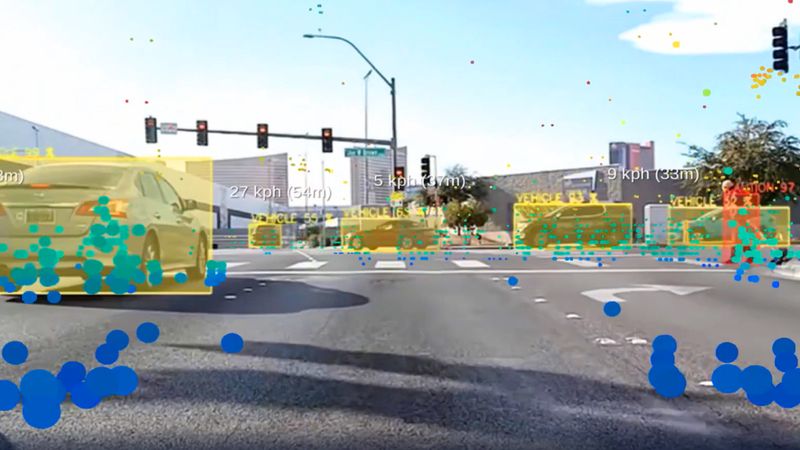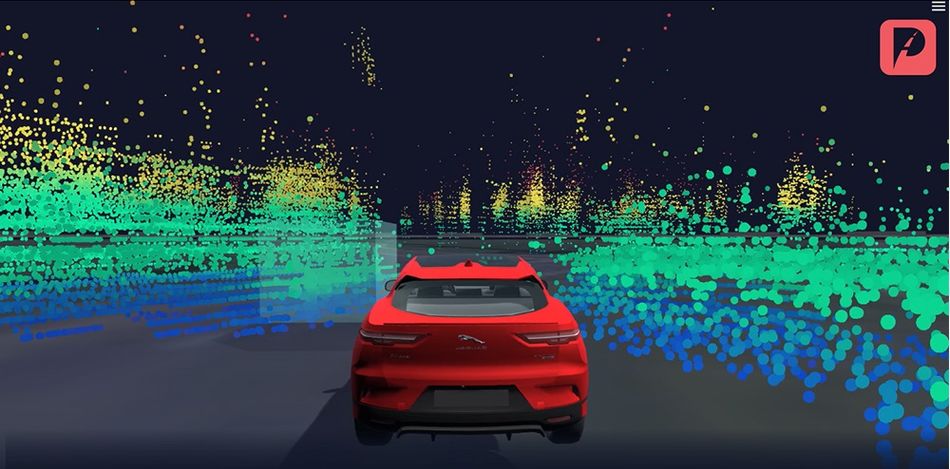Autonomus safety with radar, not LiDAR
"Safety first” is more than a catchphrase. For sensing company Provizio, it’s the only way the transportation industry should introduce autonomous vehicles.

Provizio offered demo drives of its technology on the road in Las Vegas during CES in January 2023. These images show some of what the sensors saw during the drive, along with some of Provizio’s identifying data. (Provizio)
This article was first published on
www.sae.orgFREE REPORT: Reducing Human Driver Error and Setting Realistic Expectations with Advanced Driver Assistance Systems
Thousands die or are injured each year in automobile crashes. Bringing automated driving systems technologies into the advanced driver assist systems (ADAS) and connected vehicle space will help humans drive more safely and better prepare us for automated vehicles (AVs).
Learn more about ADAS and ADS implementation with the goal of reaching zero deaths and serious injuries by downloading this FREE report from SAE International (valued at $50).

Provizio promises its 5D Perception stack can safely compete with expensive lidar sensors at a fraction of the cost.
"Safety first” is more than a catchphrase. For sensing company Provizio, it’s the only way the transportation industry should introduce autonomous vehicles. In Provizio’s view, using AV building blocks – technology such as automatic emergency braking and lane-keep assist – can be valuable in ADAS systems, but they should not be used to drive vehicles until the perception problem has been solved.
“It’s not that we’re skeptical about autonomous driving, it’s just that we strongly believe that the industry has taken this wrong path,” Dane Mitrev, machine learning engineer at Provizio, told SAE at September 2023’s AutoSens Brussels conference.
“The industry has looked at things the other way around. They tried to solve autonomy first, without looking at accident prevention and simpler ADAS systems. We are building a perception technology which will first eliminate road fatalities, then deliver next-generation ADAS – and then solve autonomy. We believe that’s the right order.”
Obviously, the industry is in favor of AVs. A group of 11 mobility and automotive companies released a 157-page paper in 2019 called “Safety First for Automated Driving.” Those companies — Aptiv, Audi, Baidu, BMW, Continental, Daimler, FCA US LLC, HERE, Infineon, Intel and Volkswagen — used the paper to propose a non-binding organized framework focused on “the development, testing and validation of safe automated passenger vehicles,” but did not attempt to establish any actual limits on what companies could do as they developed AVs. In the years since, AV technology has continued to advance, but not with the mission to solve sensing and important safety issues before teaching the vehicles how to maneuver.
Provizio’s solution is its 5D Perception driving platform, named for the way it uses five different inputs to sense the environment. There’s the 3D radar information of an object in space, plus velocity information, plus the fifth dimension: perception, which means AI embedded in the hardware. Mitrev said the final vision of this technology will be powered by radar and cameras, not light detection and ranging (lidar). Radar’s benefits are well known: the sensors are smaller (and thus simpler to integrate) and less expensive than lidar and can see in all weather conditions. For now, though, Provizio is working with lidar, especially around its hometown.
Irish sensors are smiling
Provizio is headquartered in Limerick, Ireland, and has offices in North Ireland and Pittsburgh, Pennsylvania. In late 2022, Provizio signed a deal with micromobility company Voi to test 5D perception on Voi’s scooters. Alongside potential OEM and Tier 1 partnerships he couldn’t discuss, Mitrev said Provizio also has a partnership with Jaguar Land Rover, supporting tests at a future mobility campus in Ireland.
These real-world tests involve collecting data from lidar to train the new radar AI. Provizio synchronizes the lidar and radar sensors, then extracts value from the lidar data at training time, embedding it into the neural net and teaching the neural networks based on these data streams. Imagine lidar as an old professor teaching a young radar sensor a few things, but sooner or later, the student – Provizio’s radar – won’t need the teacher anymore.
“We lean fully towards a lidar-less path,” he said. “Lidars should not be involved, even in [SAE Level 5] vehicles. They’re not necessary.”
The same is not true for cameras. To understand semantic information such as traffic signs, Provizio’s system uses cameras to augment the radar data.
“Provizio is a perception company, first of all,” Mitrev said. “We are not a radar company. We’re not a car manufacturer. We’re a perception company, we have this radar and we have a perception platform that fuses radars and cameras and provides this low-cost solution.”
Provizio was founded by Barry Lunn following the acquisition of his company Arralis, which focused on millimeter-wave communication technology for satellite communications and aerospace markets. Provizio’s radar technology grew out of radar work Lunn was familiar with in the aerospace industry. Instead of a commercial, off-the-shelf radar unit, Provizio is “redefining radars,” Mitrev said, by adding AI neural networks to the radar GPUs so all critical decisions can be made on the radar itself with less than five milliseconds latency to make those decisions. He said Provizio’s goal for its 5D radar is to see up to 600 m (1,969 feet) in 360 degrees in all weather conditions.
“Once we have this 5D perception, there is literally no reason to build any other system that will do ADAS or autonomy,” he said, adding that accident prevention is “something tangible that we can solve in the next one, three-to-five, years.”
At CES 2023, Provizio said it planned to deliver the first of its 5D Perception platforms by 2025. Provizio’s commercial strategy relies on licensing its technology to Tier 1 suppliers and OEMs. Once better sensors are in more vehicles that accurately understand the world around them, that’s when we can start letting vehicles drive themselves, Mitrev said.
“The end goal is mass adoption, to have our 5D perception on all vehicles or a lot of vehicles worldwide, then we bring down the road deaths,” he said. “We believe that this is the right path. The industry has taken this the other way around. [Starting by building a self-driving car] is just too complex, let alone with only cameras, as some companies claim.”
